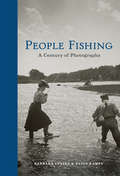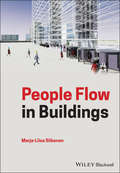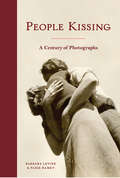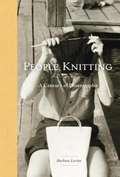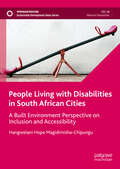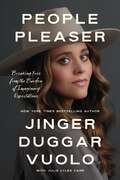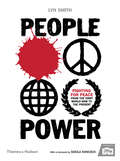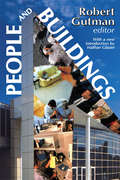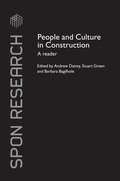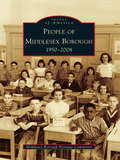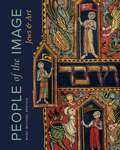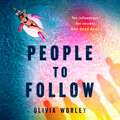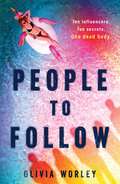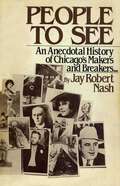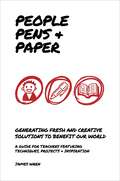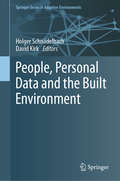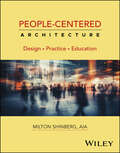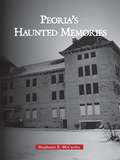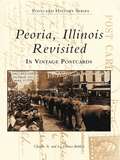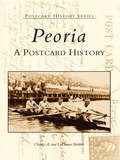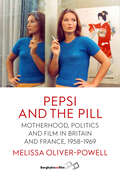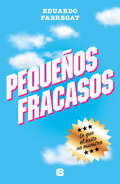- Table View
- List View
People Fishing: A Century of Photographs
by Barbara LevineAlthough people have fished for food since the dawn of time, fishing today is one of the most popular pastimes in the world—an estimated 220 million people worldwide are recreational anglers, according to the World Bank. While many enjoy the Zen of waiting patiently for a strike in the great outdoors, for others, at least judging from this quirky collection of fishermen and women fishing is clearly a time of great fun, even hilarity. In this follow-up to her delightful People Knitting, photo archivist and collector Barbara Levine, along with Paige Ramey, netted these curious, humorous, and sometimes outrageous photos of Edwardian dowagers, tiny babies, sunburned sportsmen, and bathing beauties preparing tackle boxes, casting their lures, and displaying the catch of the day. A tribute to this perennial outdoor pastime, this is the perfect book for the fisher in your life.
People Flow in Buildings
by Marja-Liisa SiikonenDiscover how to measure, control, model, and plan people flow within modern buildings with this one-stop resource from a leading professional People Flow in Buildings delivers a comprehensive and insightful description of people flow, analysis with software-based tools. The book offers readers an up-to-date overview of mathematical optimization methods used in control systems and transportation planning methods used to manage vertical and horizontal transportation. The text offers a starting point for selecting the optimal transportation equipment for new buildings and those being modernized. It provides insight into making passenger journeys pleasant and smooth, while providing readers with an examination of how modern trends in building usage, like increasingly tall buildings and COVID-19, effect people flow planning in buildings. People Flow in Buildings clearly defines the terms and symbols it includes and then moves on to deal with the measurement, control, modelling, and planning of people flow within buildings of all kinds. Each chapter contains an introduction describing its contents and the background of the subject. Included appendices describe measured passenger data and performed analyses. Readers will also benefit from the inclusion of: A thorough introduction to people-counting methods, including counting technology inside and outside buildings, passenger traffic components, and manual people-counting An examination of the passenger arrival process in building, including the Poisson arrival process and probability density function, and passenger arrivals in batches A consideration of daily vertical passenger traffic profiles, including two-way traffic profiles and the effects of inter-floor traffic An exploration of people flow solutions, including stairs, escalators, and elevators with collective and destination group control systems, as well as double-deck and multicar system People flow calculation and simulation models Elevator planning with ISO simulation method Elevator planning and evacuation of tall buildings Perfect for software designers in the private sector and academia, People Flow in Buildings will also earn a place in the libraries of elevator consultants, manufacturers, and architects who seek a one-stop reference for transportation devices from a functional and design perspective, as opposed to a hardware perspective.
People Habitat: 25 Ways to Think About Greener, Healthier Cities
by F. Kaid BenfieldWith over 80 percent of Americans now living in cities and suburbs, getting our communities right has never been more important, more complicated, or more fascinating. Longtime sustainability leader Kaid Benfield shares 25 enlightening and entertaining essays about the wondrous ecology of human settlement, and how to make it better for both people and the planet. People Habitat explores topics as diverse as "green" housing developments that are no such thing, the tricky matter of gentrifying inner cities, why people don't walk much anymore, and the relationship between cities and religion. Written with intellect, insight, and from-the-heart candor, each real-world story in People Habitat will make you see our communities in a new light.
People Kissing: A Century of Photographs
by Paige Ramey Barbara LevineLove is in the air as Barbara Levine and Paige Ramey take on humankind's oldest pastime: kissing. In racy candids, humorous vintage postcards, and snapshots taken on the sly, couples from the Victorian era through the Swinging Sixties smooch, canoodle, neck, and spoon. The collected photographs are sweet, sincere, and saucy, occasionally awkward, and always intriguing: Who took these photos? And what lay in store for these amorous couples after the shutter clicked—true love or just a passing fancy? People Kissing is the perfect gift to share with a sweetheart any day you feel like making a public display of affection.
People Knitting: A Century of Photographs
by Paige Ramey Barbara LevinePeople Knitting is a charming tribute in vintage photographs and printed ephemera to the ever-popular, often all-consuming, craft of knitting. When women posed with their knitting in the earliest nineteenth-century photographs, it demonstrated their virtue and skill as homemakers. Later, knitting became fashionable among the wealthy as a sign of culture and artistic ability. During the two world wars, images of nurses, soldiers, prisoners, and even knitting clubs composed of very serious small boys--all with heads bent down, intent on knitting items (especially socks) for the troops--abounded. In the 1950s and 1960s, as snapshots became ubiquitous, knitters took on a jauntier air, posing with handiwork held proudly aloft. People Knitting is a quirky and fascinating gift for the knitter in your life.
People Living with Disabilities in South African Cities: A Built Environment Perspective on Inclusion and Accessibility (Sustainable Development Goals Series)
by Hangwelani Hope Magidimisha-ChipunguThis book offers a unique and much-needed perspective on disability and accessibility in urban context in South Africa. Drawing on lived experiences of disabled people, it documents the multidimensional aspect of poverty in the context of disability and built environment to show how poorly planned cities create physical and social barriers that impact the life of people with disabilities. People Living with Disabilities in South African Cities is structured around three main insights and themes that inform the author's approach to disability and cities. The first is disability research; drawing on studies on planning and the built environment, the author highlights the role of physical environment in promoting inclusion and accessibility for people with disabilities. The second theme is social protection, i.e. ways to provide support and resources for people with disabilities to enable them to participate fully in society. Finally, the author explores the policies and legislative context needed to create an inclusive society, challenging the role of governments and policy makers. Offering a comprehensive approach to studying disabilities and cities, the author aims to bridge the gap between disability studies, inclusive planning, and design to support the development of accessible cities in the African context. This invaluable book not only raises awareness on social inclusion, but also offers an invaluable guide to policy makers across the Global South to tackle and address inequalities.
People Pleaser: Breaking Free from the Burden of Imaginary Expectations
by Jinger VuoloAre you a people pleaser? Can you even begin to measure how the approval of others has shaped your heart and mind? Your faith and relationships? Your habits and identity? In People Pleaser, New York Times bestselling author Jinger Vuolo shares her personal journey of constantly seeking approval from others and how she found her true identity.From childhood to early adulthood, Jinger Duggar Vuolo followed the expectations of others, never taking the time to discover who she truly was. It wasn't until she asked herself the question, "Who am I?" that she realized she was a people pleaser. This realization led her on a journey of self-discovery and ultimately, to rely on God for her approval and sense of self-worth.Through her faith and reliance on God, Jinger began to break free from the need for approval and discover true freedom. This book is a guide for anyone struggling with people-pleasing tendencies and seeking to find their true identity and purpose in life. Learn how to:discover the beauty of community and how we were made to enjoy others,identify sin and how it can hinder your ability to be in community with one another,diagnose yourself with ruthless honesty but without judgement, andunderstand who you are in God's eyes. Jinger hopes this book will inspire others to embark on a similar journey towards freedom.
People Power: Fighting for Peace from the First World War to the Present
by Lyn SmithA compelling look at war and the antiwar movement in the United Kingdom People Power charts the history of the antiwar movement in the United Kingdom from the outbreak of the First World War to present-day conflicts in the Middle East, telling the story of conscientious objectors and others who have been engaged in protest over the past century. Drawing on testimonies from the Imperial War Museum’s vast collection of recordings and documents, the book gives voice to contributors from different backgrounds and explores their wide-ranging reasons for opposing war, as well as the changes and continuity in the movement throughout these years of almost continuous conflict. The book explores the role of key organizations within the movement and tells the personal stories of high-profile individuals, including Sylvia Pankhurst, A. A. Milne, and Vanessa Redgrave, who stood out against conflict. Accompanying a major exhibition at the Imperial War Museum London in 2017, People Power provides an important and compelling look at the most divisive of human undertakings and is an essential part of understanding war as it exists today.
People and Buildings
by Robert GutmanThere is at the present time a continuing interest in relating the behavioral sciences to design disciplines. Sociologists and social psychologists have been added to faculties of architecture schools, where they off er seminars and participate as programming specialists and design critics in studio courses. Behavioral scientists in many European countries have collaborated with architects and planners in design work undertaken by governmental ministries, and more recently have been participating in the work of private design fi rms. Similar developments are now common in the United States.In this fascinating study of the "ecology of buildings," biologists, anthropologists, sociologists, psychologists, and architects analyze the effect of working and living spaces on human behavior. Focusing on such contemporary social problems as the influence of the physical environment on psychological stress, mental illness, family disorganization, urban violence, and delinquency, the contributors show that we must respect the constraints that the environment and the nature of man impose on human adaptability.The selections in People and Buildings have been written primarily by scientists and designers working in the behavioral mode. The selections within each part have been arranged to provide an ordered argument or exploration of the general topic with which the part as a whole deals. To facilitate the reader's appreciation of the argument, each selection is preceded by a short prefatory statement. In view of the fact that a single article or preface can hardly be representative of the depth of the literature that has developed around an argument, Gutman has included an annotated bibliography, which is keyed to the selections through the use of subheadings. A new introduction by Nathan Glazer has been prepared for this edition.
People and Culture in Construction: A Reader (Spon Research)
by Barbara Bagilhole Andrew Dainty Stuart GreenConstruction is one of the largest and most people-intensive industrial sectors. In many countries, however, construction is also one of the most highly criticized in terms of its employment practices and industrial relations. People and culture are too often seen as variables that must be manipulated in the cause of improved productivity. This important new work provides an essential corrective to the current literature by focusing on people and culture rather than sector efficiency. It presents the latest thinking from a diversity of perspectives derived from a major ESRC seminar series and invited contributions from leading researchers. Its interdisciplinary approach draws together industry and research and is international in its relevance. Through several multidisciplinary themes, People and Culture in Construction: explores the industry's labour market and the major influences on employment patterns examines how to improve the image and reality of the construction sector as an employer looks at the forces shaping the industry and implications for its stability considers the current composition of the workforce and the potential impacts of workforce diversification analyzes the impact of government targets and policies on construction working practices and culture investigates how to address the skills shortfall currently affecting the industry's performance.
People of Middlesex Borough: 1950-2008
by Middlesex Borough Heritage CommitteeIn 1913, a strong spirit of independence, strength of family, and desire for growth prompted a group of central New Jersey settlers to break away from the large town of Piscataway and form the borough of Middlesex. This spirit was perpetuated throughout the 20th century, accelerating the growth of a true American small-town community. People of Middlesex Borough: 1950-2008 celebrates the growth of this very special town in the second half of the 20th century. During this time period, there were major developments: schools were built and expanded and new housing developments and apartment complexes spurred the growth of the population. Parks and sports fields were established, and community services grew while local groups nurtured an already strong sense of communal awareness and responsibility. Family values, patriotism, and neighborliness have long been a part of Middlesex Borough's history, a tradition that continues today.
People of the Image: Jews and Art (Dimyonot)
by Marc Michael EpsteinThe Middle Ages provide us with one of the richest repositories of art in the West. Yet the rise in the production of art made for and by Jews—especially in the form of illuminated manuscripts—is often neglected in general surveys or viewed as a mere emulation of Christian art during this period.In People of the Image, Marc Michael Epstein demonstrates how medieval Jews transformed their visual art into a vital site of critical commentary. Through bold speculation and radical interpretation, Epstein considers how viewers might have empathized with depicted emotions, how they envisioned the relationship between the monstrous and the human, and how they could effectively perpetrate subversive acts merely by anticipating what might occur next in a given image were it to be set in motion. Examining these artworks and imagining the circumstances of their production and reception, Epstein uncovers otherwise inaccessible social, political, and theological perceptions among Europe’s major medieval minority. He goes on to illuminate the afterlives of medieval Jewish art in its reimaginings by postmodern Jews struggling to establish a conceptual as well as a political space for themselves as a minority in majority Christian society.Bringing together diverse currents from various fields and bodies of literature, People of the Image reveals how medieval Jews understood themselves, the world, and God. Provocative and engagingly written, the book will appeal to audiences across medieval studies, cultural studies, art history, and Jewish studies.
People to Follow: A Gripping Social-Media Thriller
by Olivia WorleyTen influencers. Ten secrets. One dead body. A pacy, addictive thriller perfect for fans of We Were Liars, The Inheritance Games and One Of Us Is Lying.'Agatha Christie meets TikTok . . . a wicked, juicy page-turner' - Alexa Donne, author of Brightly BurningThey're used to being followed. But not like this . . .Ten social media stars think they're about to join the cast of a hot new reality show.But the production crew never shows up, and the influencers find themselves stranded on a deserted Caribbean island with no contact with the outside world - except for messages from the mysterious 'Sponsor', who is threatening to expose their darkest secrets.When one of them winds up dead, things start to get more real than they bargained for . . .With the body count rising, the influencers must figure out who is trying to get them cancelled - like, literally - before their number one follower strikes again.
People to Follow: A Gripping Social-Media Thriller
by Olivia WorleyTen influencers. Ten secrets. One dead body. A pacy, page-turning thriller perfect for fans of We Were Liars, The Inheritance Games and One Of Us Is Lying.'Agatha Christie meets TikTok . . . a wicked, juicy page-turner' - Alexa Donne, author of Brightly BurningThey're used to being followed. But not like this . . . Ten social media stars think they're about to join the cast of a hot new reality show. But the production crew never shows up, and the influencers find themselves stranded on a deserted Caribbean island with no contact with the outside world - except for messages from the mysterious 'Sponsor', who is threatening to expose their darkest secrets. When one of them winds up dead, things start to get more real than they bargained for . . .With the body count rising, the influencers must figure out who is trying to get them cancelled - like, literally - before their number one follower strikes again.
People to See: An Anecdotal History of Chicago's Makers and Breakers
by Jay Robert NashPeople to See is an irreverent and revealing portrait of the merchant princes and magnates Marshall Field, William Randolph Hearst, P.K. Wrigley, George Pullman; crime kings Roger Plant, Al Capone, Arnold Rothestein, who fixed the 1919 World Series and "Shoeless Hoe" Jackson who played it that way; Richard J. Daley and the long line of his predecessors who insisted Chicago was not ready for reform; the proud pioneers of journalism and literature, Ben Hecht, Carl Sandburg, Nelson Algren, Saul Bellwo, Gwendolyn Brooks; and the rich heritage of Chicago sports.This is social history dominated by vivid personalities—regal and raffish characters with a talent for making out, moving up, and having their own way. They lived and often died with old-style flair and flamboyance and Jay Robert Nash presents their stories with exactly the right flavor.All the scattered fragments of the record of these originals have been searched and woven into the fabric of Chicago history. Here are zesty chronicles of those who imposed their wills in pursuit of power, profit, and pleasure int he great inland city that yields only to the bold.
People, Pens and Paper: Fresh Ideas for Schools to Teach the Creative Process
by James WrenPeople, Pens & Paper is about creative and fresh ideas. It's not a creative rule book, but a suggestive guide of techniques and projects to make the creative process more fluid and more enjoyable for students. Often, it's our setting and mindset that determines creative output, so in order to be truly effective we need to set the scene, and that also includes within ourselves. At this initial stage of the process all we need are paper, pens and people - we keep it organic and focus on generating solutions without any interference. With the projects featured, there's a focus on seeking out solutions for our planet rather than profit and commercialism. These ideas are recorded in a simple sketch book. This book can then help form a 'portfolio' of concepts for each student, so not only do the ideas look to help our world, they also show initiative and entrepreneurial flair, useful for life beyond school. From a marketing campaign for a local charity through to looking at ways to solve traffic issues at a school, teachers will be able to use innovative projects to inspire and also foster habitual ways to conceptualise, be it written or doodled.Readers will find no rules or quick-fixes.People, Pens & Paper is all about the process.
People, Pens and Paper: Fresh Ideas for Schools to Teach the Creative Process
by James WrenPeople, Pens & Paper is about creative and fresh ideas. It's not a creative rule book, but a suggestive guide of techniques and projects to make the creative process more fluid and more enjoyable for students. Often, it's our setting and mindset that determines creative output, so in order to be truly effective we need to set the scene, and that also includes within ourselves. At this initial stage of the process all we need are paper, pens and people - we keep it organic and focus on generating solutions without any interference. With the projects featured, there's a focus on seeking out solutions for our planet rather than profit and commercialism. These ideas are recorded in a simple sketch book. This book can then help form a 'portfolio' of concepts for each student, so not only do the ideas look to help our world, they also show initiative and entrepreneurial flair, useful for life beyond school. From a marketing campaign for a local charity through to looking at ways to solve traffic issues at a school, teachers will be able to use innovative projects to inspire and also foster habitual ways to conceptualise, be it written or doodled.Readers will find no rules or quick-fixes.People, Pens & Paper is all about the process.
People, Personal Data and the Built Environment (Springer Series in Adaptive Environments)
by David Kirk Holger SchnädelbachPersonal data is increasingly important in our lives. We use personal data to quantify our behaviour, through health apps or for 'personal branding' and we are also increasingly forced to part with our data to access services. With the proliferation of embedded sensors, the built environment is playing a key role in this developing use of data, even though this remains relatively hidden. Buildings are sites for the capture of personal data. This data is used to adapt buildings to people's behaviour, and increasingly, organisations use this data to understand how buildings are occupied and how communities develop within them. A whole host of technical, practical, social and ethical challenges emerge from this still developing area across interior, architectural and urban design, and many open questions remain.This book makes a contribution to this on-going discourse by bringing together a community of researchers interested in personal informatics and the design of interactive buildings and environments. The book’s aim is to foster critical discussion about the future role of personal data in interactions with the built environment.People, Personal Data and the Built Environment is ideal for researchers and practitioners interested in Architecture, Computer Science and Human Building Interaction.
People, Practice, Power: Digital Humanities outside the Center (Debates in the Digital Humanities)
by Siobhan Senier Anne B. McGrail Angel David NievesAn illuminating volume of critical essays charting the diverse territory of digital humanities scholarship The digital humanities have traditionally been considered to be the domain of only a small number of prominent and well-funded institutions. However, through a diverse range of critical essays, this volume serves to challenge and enlarge existing notions of how digital humanities research is being undertaken while also serving as a kind of alternative guide for how it can thrive within a wide variety of institutional spaces. Focusing on the complex infrastructure that undergirds the field of digital humanities, People, Practice, Power examines the various economic, social, and political factors that shape such academic endeavors. The multitude of perspectives comprising this collection offers both a much-needed critique of the existing structures for digital scholarship and the means to generate broader representation within the field. This collection provides a vital contribution to the realm of digital scholarly research and pedagogy in acknowledging the role that small liberal arts colleges, community colleges, historically black colleges and universities, and other underresourced institutions play in its advancement. Gathering together a range of voices both established and emergent, People, Practice, Power offers practitioners a self-reflexive examination of the current conditions under which the digital humanities are evolving, while helping to open up new sustainable pathways for its future. Contributors: Matthew Applegate, Molloy College; Taylor Arnold, U of Richmond; Eduard Arriaga, U of Indianapolis; Lydia Bello, Seattle U; Kathi Inman Berens, Portland State U; Christina Boyles, Michigan State U; Laura R. Braunstein, Dartmouth College; Abby R. Broughton; Maria Sachiko Cecire, Bard College; Brennan Collins, Georgia State U; Kelsey Corlett-Rivera, U of Maryland; Brittany de Gail, U of Maryland; Madelynn Dickerson, UC Irvine Libraries; Nathan H. Dize, Vanderbilt U; Quinn Dombrowski, Stanford U; Ashley Sanders Garcia, UCLA; Laura Gerlitz; Erin Rose Glass; Kaitlyn Grant; Margaret Hogarth, Claremont Colleges; Maryse Ndilu Kiese, U of Alberta; Pamella R. Lach, San Diego State U; James Malazita, Rensselaer Polytechnic Institute; Susan Merriam, Bard College; Chelsea Miya, U of Alberta; Jamila Moore Pewu, California State U, Fullerton; Urszula Pawlicka-Deger, Aalto U, Finland; Jessica Pressman, San Diego State U; Jana Remy, Chapman U; Roopika Risam, Salem State U; Elizabeth Rodrigues, Grinnell College; Dylan Ruediger, American Historical Association; Rachel Schnepper, Wesleyan U; Anelise Hanson Shrout, Bates College; Margaret Simon, North Carolina State U; Mengchi Sun, U of Alberta; Lauren Tilton, U of Richmond; Michelle R. Warren, Dartmouth College.
People-Centered Architecture: Design, Practice, Education
by Milton ShinbergShinberg has done something truly impressive: He has created a practical framework for architectural thinking and design, grounded in the latest research on human perception and cognition. His ideas and insights offer a fresh perspective that have helped me clarify many aspects of my own approach to design. —Stefan Behling, Architect, Senior Executive Partner, Head of Studio, Foster+Partners, London This book is a must-read for architects and designers at any stage of their career. His inspiring and practical narrative makes even the most complex concepts accessible. Along the way, he offers aspiring and experienced professionals a fresh perspective to reignite their passion for architecture. —Andrea de Paiva, Architect, Urban Planner, and Author, Director of NeuroAU at the University of Brasilia Milton Shinberg is at the vanguard of architects convinced that the design of buildings for people to flourish should incorporate a deep understanding of human psychology and neuroscience. A very clearly written book, rich with reflections from the science of human emotions, embodiment, and aesthetics, People-Centered Architecture will greatly enhance architectural thinking, education, and practice. —Anjan Chatterjee, MD, FAAN, Professor of Neurology, Psychology, and Architecture, University of Pennsylvania A veteran architect’s pragmatic guide to re-energizing design thinking, architectural practice and architectural education, with pivotal insights from the human sciences and wisdom harvested from non-architects. People-Centered Architecture: Design Practice Education is a unique and probing exploration designed to help architects better serve everyone who uses what architects design. In this one-of-a-kind book, architect and educator Milton Shinberg presents game-changing approaches to enhance, reorient, and re-energize design thinking. Shinberg draws from decades of dialogue with architects, designers, clients, artists, scientists, teachers, and his own students. His prompts and provocations, written in a clear and accessible narrative style, are organized to help architects, who are humanists, come to know much more about humans. Wise design becomes easier. In one concise volume, People-Centered Architecture: Design Practice Education delivers a vibrant framework for architectural practice, for students and teachers of architecture, and for clients and stakeholders. Through this book, each will see their project partners more clearly, more empathetically, and in ways that foster richer, better brainstorming and more productive collaboration. The “coalition of the curious,” people intrigued by architecture and architects, will get a peak behind the curtain.
Peoria's Haunted Memories
by Stephanie E. MccarthyAt the heart of Peoria's Haunted Memories is the rich and compelling history and folklore of the Peoria area. Buildings and cemeteries in and around the city provide ideal stomping grounds for many restless specters. In this collection of haunted sites, the reader will be introduced to some of Peoria's best-loved mansions, institutions, and graveyards, as well as many of its more illustrious citizens. From Bartonville State Hospital to Bradley University, historic downtown theaters, hotels and taverns, and local churches, where ghostly congregants and ministers continue to worship, this book presents these ghost stories and legends for the fi rst time together in print. In addition to providing thrilling tales, Peoria's Haunted Memories serves as a unique guide for the intrepid supernatural sleuth seeking confi rmation that the dead do not always rest in peace.
Peoria, Illinois Revisited in Vintage Postcards (Postcard History)
by Charles A. Bobbitt La Donna BobbittThis delightful follow-up to the first volume of Peoria: A Postcard History guides the reader through the development of Peoria to the twenty-first century. From the Illinois Riverfront to the streets of downtown, these postcards demonstrate the manychanges that have taken place in this city throughout the years. The growth and expansion in Peoria have been phenomenal, and this volume allows us to follow the timeline of the city.
Peoria: A Postcard History (Postcard History)
by Charles A. Bobbitt Ladonna BobbittFeaturing more than 200 vintage postcards, Peoria: A Postcard History captures the changing scenes of the river and downtown Peoria from 1900 to 1950. One of the largest cities in Illinios, Peoria is the seat of Peoria County and lies on the Illinois River where it forms Lake Peoria. Located in the state's central-farm country, Peoria is a manufacturing center known as the "Earth-Moving Equipment Capital of the World." Distilling has also been important in Peoria, which was home to the world's largest distillery, Hiram Walker and Sons, in 1933. Peoria: A Postcard History will allow you to visit "the world's most beautiful drive," as proclaimed by President Theodore Roosevelt during his visit to Grand View Drive in an automobile manufactured in Peoria Heights.
Pepsi and the Pill: Motherhood, Politics and Film in Britain and France, 1958–1969
by Melissa Oliver-PowellThe 1960s was a decade of massive political and cultural change in Western Europe, as seismic shifts took place in in attitudes towards sexuality, gender, and motherhood in everyday life. Through case studies of British and French films, Pepsi and the Pill offers a fresh vision of a pivotal moment in European culture, exploring the many ways in which political activity and celebrated film movements mutually shaped each other in their views on gender, sexuality, and domesticity. As the specter of popular nationalism once again looms across Europe, this book offers a timely account of the legacy of crucial debates over issues including reproductive rights, migration, and reproductive nationalism at the intersection of political discourse, protest, and film.
Pequeños fracasos: Lo que el éxito no muestra
by Eduardo FabregatComo dice Pedro Saborido en las páginas que siguen, proponerse hacer algo es comprar automáticamente la posibilidad del fracaso. Pero bajar los brazos por ello es la verdadera derrota. Nadie quiere ser asociado con esa maldita palabra, pero toda obra necesita de una serie de pequeños fracasos para llegar a buen término. En una sociedad que glorifica en exceso el éxito y la fama y a veces se regodea en la derrota absoluta, quienes se dedican al arte saben que toda creación, toda carrera, necesita de los tropiezos para crecer, y no hay allí vergüenza sino orgullo y aprendizaje. Alfredo Alcón, Eduardo Aliverti, Cristina Banegas, Julio Bocca, Adrián Caetano, Andrés Calamaro, Juan José Campanella, Diego Capusotto & Pedro Saborido, Roberto "Tito" Cossa, León Gieco, Liliana Herrero, Jorge Maronna, Lalo Mir, Ana María Shua y Julián Weich muestran el detrás de la escena de sus carreras, el ensayo y error al que se sometieron antes de acertar con el resultado esperado. En estas páginas, analizan sus encuentros con el fracaso, cómo lo convirtieron en combustible creativo, cuántos malentendidos se dan en la mirada de los demás y qué significa producir obras artísticas en esta montaña rusa llamada Argentina.
